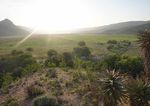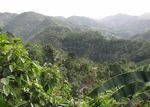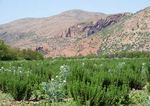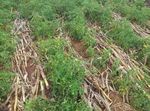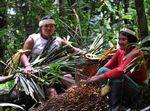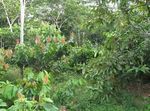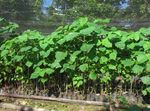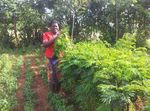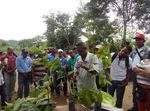On the Way to Forest Landscape Restoration - FINANCING, IMPLEMENTATION AND RECOMMENDATIONS - OroVerde
←
→
Page content transcription
If your browser does not render page correctly, please read the page content below
Forest Landscape Restoration – a global challenge p. 3
How can the restoration of forests and
landscapes work in the long term? p. 4
International regulations and global processes p. 6
Recommendations for: Implementation, financing
and enabling environment p. 8
Outlook and recommendations
for international debate p. 13
Appendix and imprint p. 15
Goal and approach
This study by OroVerde – Tropical Forest Foundation and the Global Nature Fund
(GNF) gives an overview of existing Forest Landscape Restoration (FLR) Initiatives, their
goals and the stakeholders involved. The project is financed by the Federal Agency for
Nature Conservation with funds from the Federal Ministry for the Environment, Nature
Conservation and Nuclear Safety. Recommendations were developed based on four
case studies and expert interviews. For the case studies, projects with investments or
donations from the private sector in South Africa (Commonland), Kenya (Livelihoods
Carbon Fund), Peru (Althelia Climate Fund) and the Dominican Republic (Barrick Colinas
Bajas) were visited and presented in separate publications. The analysis focuses in par-
ticular on the protection of biodiversity and the involvement of local communities and
indigenous peoples. The financing aspect was considered separately and the involve-
ment of the private sector was examined in this context. The emphasis is on promising
solutions for common challenges in forest and landscape restoration.
The case study documents can be found here: www.oroverde.de/flr
2Forest Landscape Restoration
– a global challenge
Forests are of great importance for biodiversity, climate and the conservation of water
and soil. However, the growing demand for food and other raw materials has conse-
quences, with 75% of global land areas now degraded (IPBES 2018). Forest areas are
being cleared, particularly for the production of palm oil, soybeans, beef, rubber, cocoa,
wood and paper. This development endangers not only the immense wealth of animal
and plant species, but also influences elementary ecosystem services such as climate
functions, water quality and the pollination of flowering plants.
The economic impact on society is enormous. The global cost of land degradation is
estimated at USD 23 trillion by 2050 (UNCCD 2018). The good news is that degraded
land is not irreversibly lost and more than 2.2 billion hectares of land can be restored
(Minnemeyer et al. 2011). A recent study by the Swiss Federal Institute of Technology
in Zurich (ETH Zurich) (Bastin et.al. 2019) has found that there is global potential for
the reforestation of 0.9 billion hectares which can significantly contribute to global
climate protection. The ETH Zurich is urgently calling for timely measures to prevent
Cooperation between stakeholders from politics,
the climate crisis.
the private sector, the financial sector, science
and civil society is crucial for achieving
In addition to the restoration of forests and landscapes, the protection of existing
international agreements.
forests is just as important for the climate and humanity. The above-mentioned dri-
vers of deforestation must be stopped as forest landscape restoration itself does not
tackle the causes of the problem and it takes too long to show any significant, positive
effects.
The international community has launched a number of initiatives, such as the Bonn
Challenge and the New York Declaration on Forests (NYDF), to address the issue of
deforestation and degradation. However, the actual implementation and effectiveness
of forest landscape restoration and the success of climate protection initiatives remain
unclear. In particular, implementation at a local level and the associated ecological and
social impact have so far received little attention. In addition, there is a lack of funding
for the restoration of forest landscapes.
In this study, OroVerde – Tropical Forest Foundation and the Global Nature Fund
analysed various initiatives for the restoration of forests and landscapes using private
funding and identified important success factors of the individual measures.
The transformation of rainforests into pastures
leads to the destruction of the ecosystem
and the degradation of soils.
Agroforestry systems create new sources of
income and reduce pressure on the rainforest
in the Madre de Dios region of Peru.
3How can the restoration of forests and
landscapes work in the long term?
Currently, there is no internationally accepted definition of Forest Landscape Restora-
tion (FLR). The research for this study, the literature and case studies show that there
are recurring aspects. For example, according to the Global Partnership on Forest and
Landscape Restoration (GPFLR), ‘forest and landscape restoration is the process of
regaining ecological functionality and enhancing human well-being across deforested
or degraded forest landscapes. With FLR, a diverse range of stakeholders are brought
together to identify, negotiate and implement practices that restore an agreed balan-
ce of ecological, social and economic benefits of forests and trees within a broad range
of land uses1’.
From the case studies and analysing the literature, the following important factors can
be identified for long-term, successful Forest Landscape Restoration Initiatives2.
Important factors for Forest Landscape
Restoration Initiatives
Involvement of all stakeholders in a landscape
and participatory governance
Forest landscape restoration actively involves stakeholders at different levels (inclu-
ding vulnerable groups) in planning, decision-making and implementation. For exam-
ple, in the case study in Colinas Bajas in the Dominican Republic, a general assembly was
set up with all stakeholders in the landscape. This includes government representatives,
farmers’ associations and local communities.
Integration of cultural knowledge of farmers’
Restoration of diverse functions of forests and landscapes
groups and indigenous people into the planning
process is of great importance.
Ecological, social and economic functions in a landscape are restored and ecosystem
goods and services are produced, which several stakeholders benefit from. In the
Baviaanskloof case study in South Africa, ecological functions are being restored through
regenerative agriculture and tree planting. Feed for the goats is cultivated in the valley
so that ecologically valuable Spekboom trees can grow again on the mountain slopes.
Farmers earn income from the production of essential oils.
Preservation and regeneration of natural ecosystems
Forest and landscape restoration improves the conservation, recovery and sustainable
management of forests and other ecosystems. The transformation or destruction of
natural forests or other ecosystems must be avoided. In the case study in the Domini-
can Republic, forests were restored in four phases according to the model forest concept.
The measures aim at improving the living conditions of the population and reducing the
pressure on the forest through human use. Diversified agroforestry with indigenous tree
species contributes to this goal.
1 http://www.forestlandscaperestoration.org/
our-approach-landscape-approach,
last access 20.11.2019.
2S ee the Forest Landscape Restoration Fact Sheet
for a more comprehensive description:
www.globalnature.org/en/forest-landscape-restoration
4How can the restoration of forests and landscapes work in the long term?
Adaptation to local context
Forest landscape restoration uses approaches adapted to local social, cultural, econo-
mic and environmental values, and landscape history. In the case study in Kenya, the
local population on the foothill of Mount Elgon has been involved in dairy farming for a
long time. By increasing the efficiency and use of agroforestry systems, the farmers now
generate surpluses that sustainably meet the high demand for milk.
Focus on the landscape
Forest and landscape restoration not only takes place in isolated locations, but in and
over entire landscapes. It combines mosaics of land use and management practices.
At a landscape level, ecological, social and economic aspects (ecosystems / habitats or
economic areas) can be taken into account and different requirements and expecta-
Case study Dominican Republic: The model forest
tions for landscape use can be balanced. In the South African case study, the landscape
concept involves the various stakeholders in a
approach was implemented using Commonland’s 4 Returns approach. This approach
participatory process and reduces pressure on the
combines nature conservation, moderate use and the economic use of land in one
forest through human use. New tree seedlings
landscape. This takes into account the different interests of stakeholders and enables
are growing here.
sustainable land use, resulting in four types of returns (inspirational, social, natural and
sustainable financial returns).
BANK
NGO
COOPERATIVE
© OroVerde and GNF
Fig. 1: Forest landscape restoration connects different stakeholders and land use requirements in one landscape.
5International regulations
and global processes
In recent years, several international initiatives have been launched to restore degra-
ded land and forests and improve adaptation to climate change.
The first initiative, the Bonn Challenge, was initiated at a meeting of environment
ministers in Bonn in 2011. The initiative is a global effort to bring 150 million hectares of
deforested and degraded land into restoration by 2020. The Bonn Challenge, launched
by the German government together with the International Union for Conservation
of Nature (IUCN) and the Global Partnership on Forest and Landscape Restoration
(GPFLR), aims at the practical implementation of existing environmental and climate
protection instruments. Another important milestone is the United Nations Strategic
Plan for Forests – the New York Declaration on Forests (NYDF) – of 2014. The NYDF
aims to halve deforestation by 2020, end the destruction of natural forests through
the production of agricultural commodities (mainly palm oil, paper and beef) by 2030,
and restore 350 million hectares of deforested and degraded land worldwide. The Bonn
Challenge has meanwhile adopted this goal.
Forest restoration also contributes to achieving the Sustainable Development Goals
(SDG) and, in particular, SDG 15 “Protect, restore and promote the sustainable use of
terrestrial ecosystems, sustainably manage forests, combat desertification, halt and
FOREST LANDSCAPE RESTORATION
INITIATIVES / AGREEMENTS
GLOBAL
Sustainable Paris Climate
Aichi
Development Goals Agreement
New York Bonn Land Degradation
Declaration on Forest Challenge Neutrality
REGIONAL INITIATIVES OF THE BONN CHALLENGE
NTINENT
CO Regional
African Forest Landscape
Mediterranean Central Asia
Restoration Initiative: Latin America: Southeast
Initiative
AFR100 20 x 20 Initiative Asia
STAKEHOLDER
UNTRY
CO
Governments Private Sector Civil Society Science
STAKEHOLDER
REGION
Non-Governmental Communities and
Private Sector Local Authorities
Organization Indigenous People
© OroVerde and GNF
Fig. 2: Levels from the global community to the local implementation of forest landscape restoration
6International regulations and global processes
reverse land degradation and halt biodiversity loss”. SDG 15.3 includes “Land Degrada-
tion Neutrality” (LDN), which strives to achieve a land degradation-neutral world. The
UN General Assembly adopted this in 2015. When restoring forests, it is important not
to lose sight of the loss rate and degradation, as planting trees cannot compensate for
the preservation of existing forests and their biodiversity. Figure 2 gives an overview of
the various Forest Landscape Restoration Initiatives and stakeholders involved.
Nowadays, there are a number of international agreements and initiatives. Some with
very ambitious and overlapping objectives in terms of forest restoration, biodiversity
and climate. Dialogue between the individual initiatives and stakeholders is therefore
essential to avoid establishing parallel structures in implementing these initiatives. At
the various levels, this is still a challenge for all those involved.
Within the framework of the various agreements and initiatives, the participating
countries are called upon to specify their goals for the restoration of forests (so-called
Implementation of SDGs in practice: In the
pledges). In the planning and implementation phases, NGOs and development organi-
Livelihoods Fund case study in Kenya, trees were
sations provide countries with technical support and advice. The intention is to gather
planted to store carbon and fodder trees were
experience and share it with other countries. So far, a generally accepted monitoring
cultivated to reduce open grazing areas.
system does not exist. Furthermore, it is difficult to obtain a general overview of
measures currently being implemented, particularly at local level. The Food and Agri-
culture Organization of the United Nations (FAO) carries out an assessment of forest
area (increases and losses) and forest conditions in over 200 countries. The results are
published in the Global Forest Resources Assessments (FRA) every five years. In this
context, the FAO has developed various instruments, such as Collect Earth (Open Foris)3
for forest inventories. Countries and private partners can use these inventories after a
short training period. Furthermore, there are various support tools, such as the Bonn
Challenge Barometer (InfoFLR)4 of IUCN or the Global Forest Watch website (Global
Forest Watch)5 of the World Resources Institute (WRI) and IUCN.
Measuring progress in the restoration of forests and landscapes is often based on vo-
luntary feedback from the respective countries and other stakeholders. There is often a
lack of technical quality assurance in relation to the protection of biodiversity and the
involvement of the local population. There is also a risk that large-scale monoculture
plantations will rank among the restoration initiatives. Here, criteria and standards can
provide initial assistance to ensure the conservation of biodiversity and ecosystem ser-
vices as well as the involvement of the local population in forest landscape restoration.
3 http://www.openforis.org/tools/collect-earth.html
4 https://infoflr.org/
5 Global Forest Watch: https://bit.ly/2Puy09k
7Recommendations for: Implementation,
financing and enabling environment
Effective implementation in the landscape
Projects and initiatives for forest landscape restoration are not always properly integra-
ted into a functional and diverse landscape. This can lead to conflicts with non-involved
stakeholders, contradict traditional land uses and divide ecological corridors. Ecosystem
services such as water supply and erosion control can also be affected.
The range of measures available for the restoration of forests and landscapes is wide.
These include small and very diverse agroforestry systems with native species, projects
for natural regeneration or measures for sustainable / regenerative agriculture combi-
ned with tree plantations. Currently, however, monoculture plantations with non-native,
high-quality timber combined with the protected forest areas are also among them.
The involvement of local stakeholders is just as diverse as the ecological design. Their
involvement in planning and decision-making processes is a key success factor.
Furthermore, economic profitability is of crucial importance for long-term success.
When local people associate economic benefits or improvements in their living condi-
tions with the restoration of landscapes, they are willing to take risks and change old
behaviour patterns. Many measures therefore integrate the development of agro
forestry systems. These offer various opportunities to generate income, for example
from the sale of cocoa, coffee, bananas, fruit or wood, and reduce the pressure on
existing natural forests. Since the project implementers are mostly environmental
organisations, there is not always sufficient economic expertise available to develop
business cases, establish value chains and manage companies and cooperatives.
Another crucial aspect in convincing communities and smallholders of landscape rest-
oration measures is a balanced distribution of risks. (Smallholder) farmers often take
great risks if they refrain from their traditional economic activities. They have to learn
new practices and overcome temporary income losses. Further risks are associated
with taking out loans, which are often not granted in the local currency in the case of
In workshops, groups of farmers in Colinas Bajas,
investments from abroad. This means that the local project developer or smallholder
Dominican Republic, are given the necessary
farmer also bears the risk of exchange rate fluctuations. If international markets are
knowledge for reforestation on their land. The
supplied, for example through the sale of cocoa, this also creates a dependency on
wood will generate income in a few years’ time.
market developments that are difficult to predict.
Recommendations for project developers and investors
• The landscape approach should be an integral part of planning and implemen-
ting forest restoration in order to ensure the involvement of different stake-
holders and their expectations and to preserve different ecosystem services. It
is important to build diverse systems resilient to climate change and other ex-
6 ROAM (The Restoration Opportunities Assess- ternal factors in order to ensure long-term conservation. In addition, a relation-
ment Methodology) is a framework for countries
to identify and analyse areas that are primed for ship of trust between the project developers and the local people and mutual
forest landscape restoration. https://www.iucn.org/ appreciation are key success factors of the project. There are a range of tools and
theme/forests/our-work/forest-landscape-
restoration/restoration-opportunities-assessment-
concepts available online that facilitate implementation (e. g. ROAM6; FPIC7).
methodology-roam
7 FPIC (Free, prior and informed consent) is a specific • Strengthening economic expertise at local non-governmental organisations and
right that pertains to indigenous people. It allows farmers’ cooperatives as well as at state advisory centres is an important factor
them to give or withhold consent to a project that
may affect them or their territories. http://www.fao.
in developing more sustainable enterprises and value chains.
org/indigenous-peoples/our-pillars/fpic/en/
8Recommendations for: Implementation, financing and enabling environment
• When designing investments in forest and landscape restoration, the risk must
be fairly shared between the investor and the smallholder. Project implementers
should identify the farmers’ economic risks and communicate them transparently
to the investor. In some cases, the risks for smallholder farmers are reduced by
offering in-kind packages and training instead of loans. In addition, a project
duration and an investor commitment of more than 10 years provides greater
security and creates confidence in the seriousness of the project. In the case of
state participation as a risk buffer (so-called blended finance models), this should
primarily be granted for the risks of the project implementers and smallholder
farmers. Otherwise, strict requirements should be placed on risk sharing.
Legal framework and good governance Supporting cooperatives enables the participation
of disadvantaged groups and the strengthening
Corruption, weak institutions and unclear legal frameworks are often cited as the of smallholder farmers’ negotiating power in the
major national drivers of deforestation in tropical countries. It is therefore important Mount Elgon project in Kenya.
to support these countries at a national level by strengthening the framework con-
ditions for near-natural forest restoration, sustainable land management and policy
coherence between agriculture and forestry. Investments from the private sector in
Political framework in Guatemala
rural regions require suitable framework conditions for profitable business models and
incentives for sustainable management with products from forests and agroforestry
In Guatemala, there are various political
systems. This includes certain aspects such as clarified land use rights and legal struc-
instruments and structures to promote
tures for the sale of timber and non-timber products. It takes several years for tree
forest restoration. Existing incentive
plantations and agroforestry systems to generate profits. The period from the time
mechanisms for forest protection and
the forest is established to its use by harvesting products such as cocoa and coffee is
restoration have been integrated into the
at least four years and even longer for logging. It is also important to design laws and
National Forest Landscape Restoration
regulations in a way that creates favourable conditions for development-oriented and
Strategy of 2015. For example, through the
long-term, effective investments.
PROBOSQUE Law smallholder farmers can
receive payments for the first few years of
establishing and maintaining agroforestry
systems.
Recommendations for an enabling environment
• Support and clarification of transparent land tenure and use rights, especially At the same time, there are numerous
to protect vulnerable groups from land dispossession or forced resettlement. legal hurdles for marketing forest products,
This also facilitates access to loans. The implementation of the FAO’s Voluntary especially from protected areas, while the
Guidelines on the Responsible Governance of Land, Fisheries and Forests can commercialisation of products such as beef
support countries in this. from deforested areas is much easier.
• National financial incentive mechanisms for tree planting are an interim solu-
tion for bridging the period from planting the trees to harvesting and using the
products. They are a good instrument to support smallholder farmers in bridging
this uneconomic phase. They also contribute to achieving national goals and
promoting rural development. Flexibility is important to enable project imple-
menters and smallholder organisations to adapt their planning when market
and framework conditions change.
9Recommendations for: Implementation, financing and enabling environment
• The involvement of the local population is essential for effective, long-term fo-
rest restoration. This allows traditions and cultural knowledge about cultivation
methods and plant species to be incorporated into the process. When farmers’
associations and indigenous groups are given a say, they commit themselves in
the long term to the conservation and maintenance of the land. It is important
to strengthen the population, so they can stand up for their own interests in fu-
ture and contribute to the long-term preservation of their land in a functioning
landscape.
• FLR is a landscape-based approach that involves a variety of stakeholders. This
requires all those involved to rethink their actions to include cross-sectoral and
cross-regional planning. In addition to integrated national round tables or other
common platforms, changes in education are also important. Interdisciplinary
education courses can also help.
Lack of policy coherence and incentives for forest
restoration can lead to the promotion of
monoculture plantations.
Financing forests landscape restoration
Global initiatives and agreements, such as the Bonn Challenge, have been signed not
only by states but also by civil society, indigenous peoples and private sector stake-
holders. However, past commitments are not enough. Further funds from the private
sector are therefore needed (Macqueen et al. 2018). Possible financiers include insti-
tutional investors, foundations, companies, banks and private individuals. In addition,
stakeholders from industrialised countries as well as local investors have a direct
interest in improving the ecosystems from which they obtain their products.
Private investors have very different interests and risk-return profiles. Some inves-
tors expect returns similar to those of traditional investment products, have short
investment periods and are more willing to take risks. Institutional investors, such as
pension funds, tend to seek stable returns and have long-term investment horizons.
Private foundations or companies that invest as part of their corporate responsibility
sometimes make donations or accept lower returns in order to achieve a social and
ecological impact.
Private foundations Businesses
Investment Donation or Impact Direct investment with and
Donation Impact Investment
product Investment in funds without company shares
None, moderate return Projects with suppliers /
Expected return None Capital preservation
or carbon credits Projects in sourcing regions
Risk tolerance Very high High High Moderate to high
Fig. 3: Simplified overview of private investments in forest landscape restoration
10Recommendations for: Implementation, financing and enabling environment
The agreements between investors, project developers and project implementers, the
planning of measures and the due diligence process require financial and personnel
resources and time (FAO 2018). This causes difficulties in reality, for example, due to
the expectations of the investors. The project needs to be economically profitable for
them in order to generate an appropriate return (Bor et al. 2018). This requires enabling
structures and institutions. Functioning cooperatives that bundle the sale of products,
processing, transportation and the necessary land use knowledge of smallholder
farmers are of importance. A business plan, a track record, and often collateral and
guarantees for increased risks are also required.
Many investors still focus on the economic return of the investment and the associa-
ted risks. Fund managers or project developers, however, are hardly in a position to
determine the ecological and social return and thus demonstrate the positive impact.
Therefore, it is difficult to create a holistic picture of the benefits of the investment.
The same applies to the risks of the investment. The risk assessment and due diligence
Heavily degraded areas require innovative finan-
process of investors is largely based on economic indicators. Ecological and social crite-
cing ideas and investors with longer investment
ria are currently hardly included in the risk assessment. Meaning that the potential of
periods of at least ten years, as in the Baviaans-
sustainable forms of land use to reduce risks and conflicts is not taken into account.
kloof in South Africa.
Investors, such as institutional investors or investment funds with high investment
volumes, prefer to invest their capital in a small number of larger projects in order to
keep administrative expenses and costs low. This poses major challenges for project
developers, especially when smallholder farmers are involved and species-rich systems
are established in the landscape. It is difficult to generate a high return with small-
holder structures and species-rich systems in long-term projects. The reasons are the
high coordination effort involved, the necessity of capacity building and the required
differentiated knowledge of sustainable cultivation methods. Often the smallholder
families themselves have an income below the subsistence minimum. Forming part
of projects to develop forest and agroforestry systems could improve their livelihood.
However, in this kind of projects high incomes for farmers and attractive returns for
investors are rarely generated.
Simple agricultural practices such as mulching do
not require investment and improve soil quality
and food production in the Mount Elgon
project in Kenya.
Wealthy individuals with
Institutional investors Financial institutes
mixed portfolios
For FLR:
Funds or blended finance models with blended finance, impact investments in
Loans, bonds
public money as a risk buffer funds, direct investments with or without
shares, donations
Moderate to market return Market return For FLR rather low return
Low to moderate Low to moderate For FLR rather high
11Recommendations for: Implementation, financing and enabling environment
Recommendations for financing forest landscape restoration
• Developing innovative financing instruments to also cover the establishment of
local structures and projects. One possibility is the provision of funds for capacity
building (Technical Facility) as well as independent funds to develop local struc-
tures. Case Study: The Althelia Climate Fund is financing the establishment of a
smallholder farmers’ cooperative in Peru to process and sell cocoa from established
agroforestry systems. An external manager supports the organisational develop-
ment and capacity building.
• In addition to improved monitoring of ecological and social aspects, research
work is needed to determine ecological and social returns as well as the risk
reduction potential of forest and landscape restoration projects. Practical exam-
ple: The Dutch &Green Fund has set itself the target of an ecological return of
5 million hectares of protected or restored tropical forest. The ecological return
With the Mount Elgon Project in Kenya, the Live-
will be measured using transparent indicators.
lihoods Carbon Fund is helping 30,000 farmers
to increase their (agricultural) productivity and • Realistic return expectations are necessary for investors. Return rates of bet-
improve soil quality through sustainable practices. ween two and four percent are more likely to be achieved than market returns.
It is also helpful to include ecological and social returns as well as the fact that
sustainable management can lead to reduced risks.
• Financial support from investors for preparatory and initial phases as well as
capacity building is beneficial to speed up the process and enable the partici-
pation of local non-governmental implementers. It is important to restrict this
support to initiatives that work with species-rich systems, conserve biodiversity
and actively involve the local population. In addition, technical support is helpful
for project implementers to enable the compilation of the relevant financial data.
This provides investors with a realistic assessment of the ecological and social
risks and positive impacts of forest landscape restoration.
The cultivation of rosemary mixed with other crops
and the production of essential oils allow farmers
to reduce livestock and provide land for landscape
restoration in the Baviaanskloof in South Africa.
12Outlook and recommendations
for international debate
This study highlights key approaches for involving private sector investments in forest
landscape restoration. In order to achieve the ambitious global goals, appropriate pre-
conditions must be considered in the international debate. The following three general
recommendations go beyond local implementation.
At an international level, the transferability and scalability of promising measures are
often discussed. However, the case studies have shown that in many cases implemen-
tation is highly dependent on local conditions. This relates to ecological aspects such
as the degree of degradation, precipitation patterns as well as social aspects and the
living conditions of local people. In addition, the existence of infrastructure and legal
frameworks as well as suitable implementation partners play decisive roles. This ma-
kes it difficult to transfer and scale promising measures.
Recommendations for transferability and scalability FLR actors and investors come together at different
levels (landscape, regional and national).
The development and targeted promotion of local partners with strong imple-
mentation capabilities and suitable capacities is crucial to achieve transferability
and scalability. Government support for organisational development and the
reduction of transaction costs in the initial phase are essential for implementing
long-term measures.
For the dissemination and transfer of FLR measures, it is also necessary to clarify
which measures are promising and positive in the long term for biodiversity and local
communities. Monoculture plantations, which generate returns that can be easily
determined and are supposedly low-risk, may make sense temporarily, but they cannot
be seen as measures to rebuild functional landscapes. Therefore, not all local projects
make a long-term contribution to restoring degraded areas and improving the living
conditions of the local population. In some cases, economic interests, such as returns,
take precedence over ecological and social functions and thus impair the long-term
sustainability of the initiatives.
Recommendations for minimum requirements
or exclusion criteria
To ensure that FLR Initiatives for the restoration of forests and landscapes at an
international level do not risk becoming unreliable or meaningless, it is import-
ant to develop internationally recognised minimum requirements or exclusion
criteria for the selection of promising FLR measures. These requirements and
criteria should include the rights of local communities and indigenous peoples,
consultation and participation processes, and environmental aspects, particularly
in relation to natural forests and biodiversity, as is already the case in other inter-
national safeguards.
13Outlook and recommendations for international debate
Most forest and landscape restoration projects are still in their initial stages. Their
long-term ecological, social and economic effectiveness has not yet been proven. This
also leads to the problem that less sustainable ideas are considered part of the FLR in-
itiatives. Moreover, many project developers and investors do not sufficiently consider
the post-investment phase.
Recommendations for sustainability and actual effectiveness
Ensuring the sustainability and actual effectiveness of projects must be gi-
ven greater consideration. This needs to be an integral part of planning and in
discussions on measures for the reforestation of biodiverse forests landscapes in
cooperation with the local population. Therefore, stable value chains and lasting
incomes for smallholder farmers need to be ensured. They must be able to sustain
themselves after the project has ended. In addition, a monitoring scheme should
prove the effectiveness of soil regeneration, resilience to climate change and the
improvement of biodiversity.
Support programmes such as those in Guatemala are an important instrument to foster the
development of agroforestry systems and reduce risks for farmers.
14Appendix and imprint
This publication is part of the project “Analysis of Forest Landscape Restoration Initia-
tives and the ecological and social impact of implemented projects”. The project was
funded by the Federal Agency for Nature Conservation with funds from the Federal
Ministry for the Environment, Nature Conservation and Nuclear Safety. The document
reflects the views of the funding recipients and do not necessarily coincide with the
views of the funding agencies.
Bibliography: November 2019
Bastin, J.-F., Finegold, F., Garcia, C., Mollicone D., Rezende, M., Routh, D., Zohner, C. M., Layout: Fabienne Schovenberg –
Crowther, T. W., 2019. The global tree restoration potential. SCIENCE. 5 JULY 2019 • VOL Communication and design for humanity,
365 ISSUE 6448. p. 76–79. environment and future ability
www.fabienneschovenberg.de
Bor, A-M., Duke, G. and Kisielewicz, J. (eds) (2018): Positive Impact Finance for Business kontakt@fabienneschovenberg.de
& Biodiversity. EU B@B Platform, Brussels. fa b i eennnnee ssch
c hove
o vennb ebregr g
FAO (2017): Report on the Forest and Landscape Investment Forum – Unleashing Busi-
Translation from German:
ness Opportunities for Sustainable Landscapes, Rwanda May 2017.
Andrea Reuter (GNF), Lorraine Ewen –
English Training & Translation Services
IPBES (2018): The IPBES assessment report on land degradation and restoration. Mon-
tanarella, L., Scholes, R., and Brainich, A. (eds.). Secretariat of the Intergovernmental
Publisher:
Science-Policy Platform on Biodiversity and Ecosystem Services, Bonn, Germany.
Macqueen, D., Benni, N., Boscolo, M., Zapata, J. (2018): Access to finance for forest and
farm producer organisations (FFPOs). FAO, Rome and IIED, London, pp.98. Licence: CC
BY-NC-SA 3.0 IGO.
Minnemeyer, S., Laestadius, L., Sizer, N., Saint-Laurent, C. & Potapov, P. 2011. A world of
opportunity. The Global Partnership on Forest and Landscape Restoration, World Re-
sources Institute, South Dakota State University and IUCN: http://pdf.wri.org/world_
OroVerde
of_opportunity_brochure_2011-09.pdf
Tropical Forest Foundation
UNCCD 2018: Poor land use costs countries 9 percent equivalent of their GDP. Press
Burbacher Straße 81
release: 15.05.2018. https://www.unccd.int/news-events/poor-land-use-costs-coun-
53129 Bonn
tries-9-percent-equivalent-their-gdp-0
Tel.: +49 228 24290-0
For reasons of better readability, we have decided to use the male form in this publi-
Fax: +49 228 24290-55
cation. However, this should not be understood discriminatory. We ask all women and
www.oroverde.de
girls to feel equally addressed.
info@oroverde.de
Legally responsible for the content:
Udo Gattenlöhner (GNF), Dr. Volkhard Wille (OroVerde)
Authors: Anique Hillbrand (OroVerde), Andrea Reuter (GNF), Elke Mannigel (OroVerde),
Torsten Klimpel (OroVerde), Michael Metz (OroVerde)
Picture Credits:
Global Nature Fund (GNF)
International environment and
aphotostory, Shutterstock (p. 1)
nature foundation
Gondecki, P. (p. 4)
Klimpel, T., OroVerde (p. 5 above, p. 10)
Fritz-Reichle-Ring 4
Mannigel, E., OroVerde (p. 3 middle)
78315 Radolfzell
Metz, M., OroVerde (p. 3 below, p. 14)
rawpixel, Pixabay (p. 3 above)
Tel.: +49 7732 99 95-80
Reuter, A., Global Nature Fund (p. 11 above, p. 12 below, p. 16)
Fax: +49 7732 99 95-88
Schovenberg, F. (p. 5 Fig. 1, p. 6 Fig. 2)
www.globalnature.org
Schwarz, M. (p. 7, p. 9, p. 11 below, p. 12 above)
info@globalnature.org
Valerio, M. (p. 8)
15This project was sponsored by the Federal Agency for Nature Conservation with funding from the Federal Ministry for the Environment, Nature Conservation and Nuclear Safety.
You can also read

